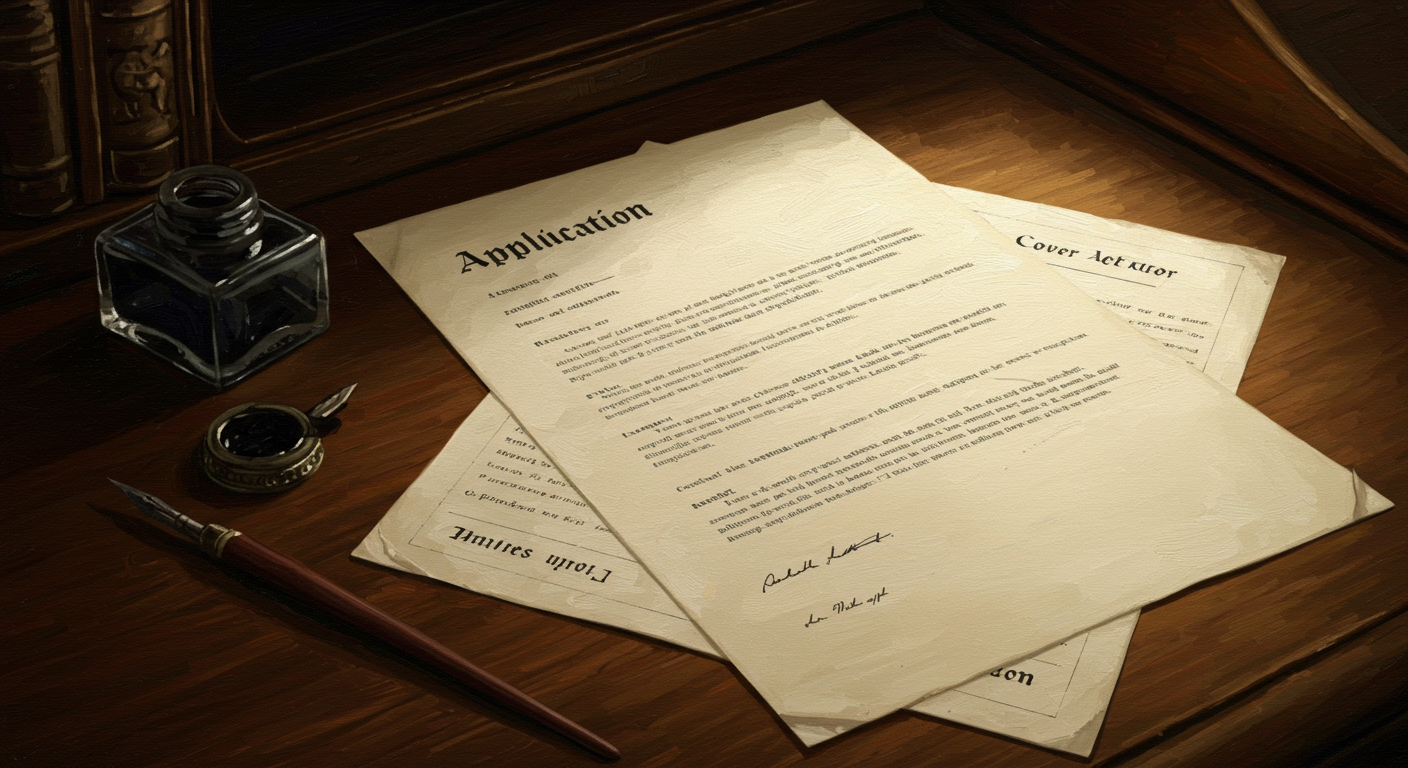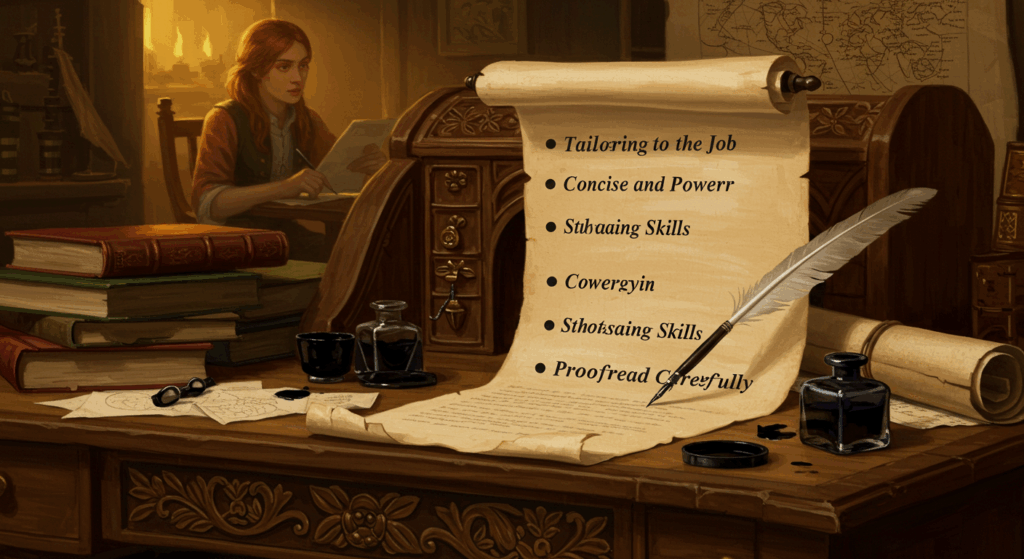The Chill, Real-Talk Guide You Actually Need
You know that moment when Netflix asks, “Are you still watching?” and you’re like, “yes… but also I should probably work on my job stuff”? Same. If you’re stuck debating whether you need an application letter or a cover letter (or if those two are just twins with different haircuts), this is for you. I’m going to break down the whole application letter vs cover letter situation in plain English, with examples, writing differences, and a few low-key pep talks. We’ll keep it casual and human—like a friend who’s into career stuff but still texts you memes at 2 a.m.
Before we jump in: both documents try to convince someone to hire you, but they don’t play the same role. Think of it like dating apps. Your profile (resume) is the facts: height, hobbies, “loves long walks to the fridge.” The message you send (letter) is the vibe: why you’re reaching out, what you bring, and a tiny teaser of your personality. Now: which message is which, and when do you send each? Let’s go.
The Quick-and-Dirty: Application Letter vs Cover Letter
- Cover letter: A short, tailored note that introduces your resume for a specific opening. It’s like: “Hi, I saw your job post for Social Media Manager, here’s why I fit.” One page or less. It’s tightly focused, like a perfect 30-second TikTok hook.
- Application letter: A more complete letter that can sometimes function even without a resume. You introduce yourself, outline key skills/experience, and make a case for why you’re a match—especially useful for unsolicited inquiries (aka “speculative” applications) or when the company expects a formal letter beyond the cover page.
TL;DR on writing differences: A cover letter is a concise “trailer” for your resume. An application letter can be the “mini-movie”—still tight, but with more substance or formal framing.
Why People Confuse Them (it’s not your fault, promise)
Okay, so in some countries and industries, people use the terms interchangeably. You’ll even see job portals mixing them up. That’s why “application letter vs cover letter” gets search traffic, which spirals into mass confusion (ngl, I’ve been there). The best move is to read the job ad and local norms. If you see “Submit a cover letter and CV,” they probably want the classic short intro letter attached to your resume. If they say “send your application letter,” it usually means a more formal, comprehensive letter—often in the body of the email or as a primary doc.
Letter Types You’ll Actually Use
Here are the letter types you’ll bump into most:
- Cover letter for a posted job
- Short, tailored, references the job title and company.
- Connects 2–3 achievements to the role’s must-haves.
- Designed to make the recruiter go, “Okay, open the resume.”
- Application letter for a posted job
- More formal or detailed than a cover letter.
- Can stand on its own if needed (still include your resume though, if asked).
- Useful when the listing specifically requests an “application letter.”
- Speculative/Prospecting application letter
- You’re reaching out without a posted role, or you’re exploring hidden oportunities.
- A little more narrative: why them, what problems you can solve, and what role(s) you could fit.
- Referral-based cover letter
- Short and sweet, name-drops the referrer early (“[Name] suggested I get in touch”).
- Still a cover letter, but the referral changes your intro strategy.
- Career-change letter (cover or application)
- Focuses on transferable skills, relevant projects, and your “why now.”
- You’ll explain the bridge between your past and this new direction.
Writing Differences That Matter (so you don’t get ghosted)
Let’s get practical about writing differences:
- Length & depth
- Cover letter: ~250–400 words. One page max (ideally less).
- Application letter: ~400–700 words. You can go deeper, but keep it crisp; no one wants a novel.
- Tone
- Cover letter: targeted, energetic, professional-friendly.
- Application letter: slightly more formal, especially if speculative or for more traditional fields (think government, academia, or ultra-corporate).
- Structure
- Cover letter: Hook → Why you fit 2–3 key needs → Small proof points → Call-to-action.
- Application letter: Context + why you’re writing → Key capabilities/achievements → Why this company/department → CTA. More complete arc.
- Use case
- Cover letter: Always attach to a specific posting unless they say it’s optiomal. (Even then… consider adding one if you can keep it tight.)
- Application letter: Use when the ad requests it, or when you’re proactively pitching yourself to a company or team.
How to Format Both (aka “what do I even put at the top?”)
Header
- Your name, phone, email, city (optional), LinkedIn/portfolio links. Keep it clean; no Comic Sans (pls).
- Date.
- Hiring manager’s name and title (if known), company name, address (if formal), or simply “Dear [Team/Name]” if email.
Greeting
- Ideally, “Dear [Name]” (spelled correctly—check that LinkedIn twice).
- If you truly can’t find a name: “Dear Hiring Manager” or “Dear [Department] Team” works.
Paragraph Flow (cover letter)
- Opening hook: Job title + 1–2-line punch about your fit.
- Proof section: 2–3 tight bullets or short paragraphs mapping your results to their needs.
- Why them: Show you did homework (product, mission, recent launch).
- CTA: “I’d love to talk more about X and how I can help with Y.”
Paragraph Flow (application letter)
- Intro: Why you’re writing (posted role or speculative), your core value in one line.
- Experience snapshot: A compact narrative with quantified wins (or relevant projects if early-career).
- Company alignment: Why this company and how you’d contribute; mention teams/problems you can help with.
- Closing & CTA: Availability, portfolio links, appreciation.
Example: Short Cover Letter (Posted Role)
Scenario: Marketing Coordinator role at StreamWave (fake, but sounds like a platform you’d binge).
Subject (email): Application for Marketing Coordinator — [Your Name]
Dear Maya Chen,
I’m applying for the Marketing Coordinator role at StreamWave. In my last role at Volt Studio, I boosted TikTok engagement 87% in 3 months by remixing long-form trailers into snackable clips and experimenting with creator duets. I also managed a 6-figure ad budget without lighting it on fire (lol), running weekly A/B tests to lower CAC by 21%.
Your listing calls for someone who can build creator partnerships and measure growth. I launched a micro-creator program (25 partners) that delivered 1.6M qualified views in 8 weeks and a 12% follower-to-trial conversion rate—tracked with UTM parameters and Looker dashboards I set up with our data team.
I love StreamWave’s push into indie content (the “Fresh Cuts” series is so smart). I’d be excited to help scale those drops across TikTok and Shorts while keeping your brand voice playful, not cringey. I’ve attached my resume and portfolio for context.
Thanks for considering me,
[Your Name]
[Phone] | [Email] | [LinkedIn] | [Portfolio]
Notes: short, specific, hits needs, no fluff. Exactly what a cover letter should be.
Example: Application Letter (Speculative Inquiry)
Subject (email): Application Letter — Product Analyst (Exploratory)
Dear Data & Product Analytics Team,
I’m writing to express interest in upcoming Product Analyst roles at AcornPay. I specialize in growth analytics, funnel diagnostics, and translating murky “what are we even measuring” moments into clear dashboards and experiments.
At Ledger.app, I partnered with product and lifecycle marketing to rebuild onboarding tracking. We discovered a 22% drop-off on step two due to an unclear KYC tooltip (wild). We shipped a microcopy fix and reordered steps, which lifted completion 13% and increased week-two retention by 7%. I also led monthly experiment reviews (about 8–12 tests/month), built a self-serve Looker layer for PMs, and reduced “can someone pull me this metric?” Slacks by ~60%.
I’ve been following AcornPay’s features in B2B checkout and subscription tooling. If you’re exploring onboarding simplification, self-serve dashboards for mid-market clients, or churn prediction models, that’s exactly my lane. I’d love to share how I approach instrumenting events, building experiment templates with guardrails, and keeping teams honest about sample size (I bring snacks and patience).
I’ve attached my resume and a brief portfolio (docs). If you’re open, I’d appreciate the chance to chat or contribute a short take-home. Thanks for reading.
Sincerely,
[Your Name]
[Phone] | [Email] | [LinkedIn] | [Portfolio]
Notes: a bit longer, more formal, still friendly. Works when there’s no live posting or when they say “send an application letter.”
How to Tailor Without Spending 100 Years
- Mirror the job ad’s keywords (the legit ones, not buzzword soup). If they say “SQL, A/B testing, cohort analysis,” use those exact phrases once or twice where it makes sense.
- Pick 2–3 proof points that align with their top needs. Don’t list everything you’ve ever done—choose the most relevant 5% and go deep.
- Add a 1-liner about why them (product you like, recent launch, mission). This shows you’re not carpet-applying like a bot.
- Keep the resume and letter synced. If you brag in the letter, the resume should back it up with the same numbers.
What to Say When You Don’t Have “Experience” Yet
New grads, career-changers, return-to-work crew, this is for you. You still have proof points—just not in the traditional “2–5 years” bucket.
- Projects (school, bootcamp, personal): highlight outcomes, not just tasks.
- Internships or volunteer work: quantify anything you can.
- Competitions or hackathons: what did you build, what was the impact?
- Transferable skills: communication, project management, detail orientation, customer empathy. No, it’s not fluff if you tie it to real examples.
Cover letter example line:
“For my capstone, I built a pricing dashboard that reduced our simulated decision time from ~3 days to <24 hours—happy to show you the repo and a 2-min Loom.”
Tone Check: Professional, but Not Robotic
You don’t have to write like a 19th-century butler. Friendly-professional is perfect. A tiny dash of personality (one joke or aside) makes you feel human. Just… don’t overdo it. If the company page screams “we are serious wizards,” maybe ditch the “lol.”
- Good: “I’m excited by your mission to make climate tech accessible—amd I’d love to help scale your onboarding funnel without sacrificing accuracy.”
- Eh: “omg hiiii I love what u do pls hire me.”
- Too Formal: “It is with utmost deference I submit my humble candidacy…”
Mistakes That Make Recruiters Sigh (and how to fix them)
- Not naming the role
- Put it in the subject and first line. Make it painfully obvious.
- Telling, not showing
- “I’m a hard worker” vs “I shipped 14 creator partnerships in Q2 that drove 2.1M views.” Numbers win.
- Copy-pasted wallpaper
- If your letter could be sent to any company, it’s not tailored enough.
- Long blocks of text
- Use short paragraphs, strategic bullets, and white space. Reading on phones is real.
- No CTA
- Tell them what happens next: “I’d love to share a quick case study or jump on a 15-minute intro call.”
- Typos in names/titles
- Triple-check. It’s like calling your date the wrong name—awkward and avoidable.
ATS, Email, and File-Name Stuff (aka the unsexy but crucial bits)
- File names:
Firstname-Lastname-Resume-Company-Role.pdfandFirstname-Lastname-CoverLetter-Company-Role.pdf. Clean and searchable. - PDF everything (unless the posting specifies otherwise). Keeps your formatting stable.
- Email vs portal: If emailing, paste the cover letter in the email body and attach the PDF; for application letters, either attach as PDF or make it the email body depending on instructions.
- Subject lines: “Application — [Role], [Your Name]” or “Cover Letter — [Role], [Your Name].” Simple is best.
SEO-ish Clarity Corner (because you asked): Application Letter vs Cover Letter
If you’re literally googling application letter vs cover letter, here’s the punchy version you can screenshot:
- Cover letter
- Short intro for a posted role.
- Supports your resume.
- Targeted bullets and proof.
- Tone: confident, friendly.
- Application letter
- More formal or comprehensive.
- Can be used for posted or speculative roles.
- Includes a fuller narrative of your fit.
- Tone: professional, slightly longer.
Writing differences in one line: cover letter = concise pitch for a specific opening; application letter = broader, sometimes standalone pitch that can work even without a posting.
Letter Types by Situation (choose your fighter)
- Early-career or career-change + posted job → Cover letter (keep it tight; lean on projects).
- Established pro + posted job → Cover letter if asked; application letter if requested by the listing.
- No posted job, but you love the company → Speculative application letter.
- Government/academic roles → Often lean “application letter.” Check instructions carefully.
- Introduced by a referral → Cover letter, namedrop early (“[Referrer] recommended I reach out”).
Mini Swipe File: Phrases You Can Steal (and tweak)
- Opening hooks
- “I’m applying for the [Role] role—drawn by your push into [specific initiative].”
- “As a [current role] who’s grown [metric] by [X%], I’m excited to bring that same focus to [Company].”
- Proof lines
- “I led [project] that [result], reducing [cost/time/error] by [X%].”
- “I collaborated with [team] to ship [feature], which increased [metric] by [X].”
- Why-you
- “Your [mission/product] resonates because [personal reason]. I’d love to contribute to [specific team/problem].”
- Closers
- “I’d be happy to share a brief case study or jump on a short call to discuss how I can help with [initiative].”
- “Thank you for your time—looking forward to next steps.”
What If You’re Applying Internationally?
- Title language: Some regions use “application letter” more commonly; mirror the posting.
- Formality: If the culture leans formal, nudge your tone up a notch.
- Spelling: US (organize) vs UK (organise). Keep it consistent with the company’s style.
- Address blocks: In more formal contexts, include full address and date at the top; in US tech, a simple header is fine.
How to Edit Without Losing Your Soul
- Read out loud. If you stumble, the recruiter will too.
- Trim 20%. Almost every first draft has extra fluff.
- Replace adjectives with proof. “Strong communicator” → “Facilitated weekly cross-team standups; cut handoff delays 18%.”
- Check vibe vs industry. Startups tolerate a little sparkle; big banks want fewer winks.
FAQs You Might Be Thinking (but didn’t want to ask)
1) Can I reuse the same letter for multiple jobs?
You can, but you shouldn’t. Make a base template and customize 30–40% every time.
2) Do people actually read these?
Yes. Maybe not everyone, but the right someone does—especially hiring managers. A tight letter can be the tie-breaker.
3) What if the posting says “cover letter optional”?
If you’re short on time: apply anyway. If you want an edge: include it. Optional = “secret advantage for people who try.”
4) Is a cover letter ever better as bullets?
Totally. A short paragraph + 2–3 bullets is clean and skimmable.
5) How do I handle a big employment gap?
Name it once without oversharing, focus on recent projects/skills, then push forward. “During 2023 I cared for family and completed [course/project]; I’m excited to bring [skill] back to a team.”
Two Fill-in-the-Blank Templates (fast, not soulless)
Cover Letter (Posted Role)
Dear [Name],
I’m excited to apply for the [Job Title] role at [Company]. In my recent work at [Current/Last Company], I [achieved X] by [doing Y], which led to [quantified result]. Your posting mentions [skill/requirement 1] and [skill 2]; I’ve used those to [brief example].
A few highlights aligned to your needs:
- [Skill/Tool] — used to [result]
- [Project/Outcome] — led to [metric]
- [Collaboration/Leadership] — partnered with [team] to [result]
I admire [Company/mission/product] and would love to contribute to [specific initiative]. I’ve attached my resume and [portfolio/GitHub].
Thanks for your time,
[Your Name]
Application Letter (Speculative or Requested)
Dear [Name/Team],
I’m writing to express interest in [role/team focus] at [Company]. My background includes [core skills] and [relevant results], and I’m particularly drawn to [company initiative/mission].
At [Previous Company], I [project/impact] resulting in [metric/result]. I also [second achievement], which helped [stakeholders/team] achieve [result]. I’m comfortable with [tools/stack] and enjoy [collaboration style].
If there’s an opportunity to contribute to [team/project], I’d welcome the chance to chat or complete a brief exercise. Resume and [portfolio/links] attached.
Sincerely,
[Your Name]
Final Comparisons Table (bookmark this)
- Purpose
- Cover letter: Introduce resume for a posted job.
- Application letter: Provide a fuller pitch, sometimes unsolicited.
- Length
- Cover letter: 250–400 words.
- Application letter: 400–700 words.
- Tone
- Cover letter: Focused, friendly.
- Application letter: Formal-ish, narrative.
- Best for
- Cover letter: Specific openings, online portals.
- Application letter: Speculative outreach, roles that request it, traditional sectors.
- Core writing differences
- Cover letter: punchy, role-linked, resume-supporting.
- Application letter: broader story, can stand alone, stronger “why me + why you.”
Tiny Style Upgrades That Make a Big Difference
- Numbers early: Don’t bury your best metric in paragraph four.
- White space: Short paragraphs = recruiter-friendly.
- Keywords smartly: Sprinkle the role’s core skills—don’t keyword-stuff.
- Link tastefully: Portfolio, GitHub, Behance, Substack—whatever proves your work.
- Confidence over apology: Avoid “I think I could maybe possibly…” You’re capable. Own it.
Wrap-Up: You’ve Got This (for real)
If you remember nothing else: a cover letter is your tight pitch for a specific role; an application letter is your fuller pitch that can work with or without a posting. That’s the heart of application letter vs cover letter, the key letter types, and the practical writing differences you’ll use in the real world. Keep it short, specific, and you-shaped. Let your proof points lead. And hey—send the thing. Perfect is the enemy of hired.
If you want, drop me the job ad and your rough draft (typos and all). I’ll help you sharpen it so it actually sounds like you—and gets you that interview. Now go hit “apply” and then reward yourself with an episode (or three).









